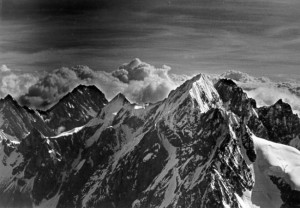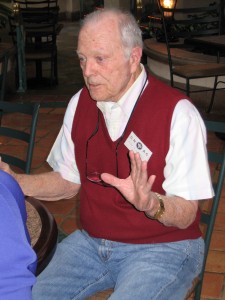
The reunion room thundered with band of brothers camaraderie, packed with overjoyed old dudes slapping backs and bellowing into each other’s hearing aids, faces flushing red as they roared greetings and good-natured abuse. Hard-earned exuberance: not a man among them had less than a thousand hours of combat flight time. During the 1930s and ‘40s, these daredevil pilots flew for the China National Aviation Corporation (CNAC), and they pioneered and prosecuted the most dangerous airlift in history, braving high mountains, horrible weather, and Japanese fighter planes to fly supplies over “The Hump” – the 18,000 to 23,000 foot mountains of the Eastern Himalayas that stood between Kunming, China, and the Allied supply bases in Assam, India. Fully loaded, their twin-engine transports couldn’t fly over the mountains, they had to thread around the highest peaks, hoping they wouldn’t be trapped by foul weather or box canyons. Trusting everything to their skill, primitive, albeit sturdy airframes, crude instruments, and rudimentary navigational aids, they flew the Hump day in and day out for more than three years.

In the aftermath of Pearl Harbor, the Japanese captured Burma and cut the Burma Road, isolating free China in the Asian interior behind the Eastern Himalayas. (Even today, in a world seemingly crazed by mountain adventure, many, even most, of these mountains remain unclimbed.) China’s only hope of maintaining ties with the outside world was the untried aerial supply route over the Hump. The U.S. Army Air Corps didn’t think it could be done, and said so in Washington. CNAC’s example proved otherwise, and President Roosevelt pointedly asked the Army: If they can do it, why can’t you?

Of course, the Army Air Corps hated CNAC The airline’s pilots could earn $2,000 a month, ten times what the typical Air Corps pilot made for similar work, and CNAC existed beyond the reach of “chickenshit” military discipline. What an airline man did off-duty was his own business. But the U.S. Army mostly flew in daylight, mostly in decent weather, and considered a tour complete and sent a man home when he had done a hundred Hump missions. CNAC flew day and night, in all weathers, and many CNAC pilots made more than five hundred trips over the Hump. Flying unarmed transports over the Himalayas may sound boring and routine, and to a certain extent it was, but make no mistake, flying the Hump was a high stakes game. 32 CNAC pilots were killed during the war. The Army Air Corps, flying routes the airline had pioneered, lost a plane every two days. By the end of the war, two thousand fliers had been lost on the Hump.

A hodgepodge of Chinese and Western pilots straggled into the CNAC ranks from odd corners of the aviation world, maverick aerial flotsam of a world at war. Among them were ex-military, ex-Flying Tigers who signed on with CNAC when the AVG disbanded (American Volunteer Group): Californian ace Dick Rossi, credited with gunning down six Japanese planes, Scandinavian golden boy Einar “Mickey” Michelson who once finagled a date with Madame Chiang Kai-Shek, and iron-willed Joe Rosbert, who crashed in the high Himalayas and made an epic 47-day trek to safety through blizzards, glaciers, and stone-aged headhunting tribes – on a broken leg – that ranks with the great survival stories of all time. Chinese and Chinese-American pilots like Moon Chin and Harold Chinn had been with the airline since the 1930s. Jim Fox, Ridge Hammell, and big, barrel-chested Pete Goutiere joined CNAC when they were stranded in Asia by the collapse of Pan Am Air Ferries. Others, like Donald McBride and Bill Maher, were frustrated flight instructors refused admission into the Air Corps or naval aviation who abandoned their cush stateside jobs for the spice of combat. Outcasts in a forgotten theater of the world war, they happened to be the very best at what they did, and I soon realized their collective memory holds one of aviation’s great untold stories.
The constant danger provoked extreme reactions. Some men clamed up and salted away their outrageous mercenary earnings with near-religious devotion. (After the war, CNAC money gave birth to both Cathay Pacific airways and the Flying Tiger Line.) Others, like wildman Jimmy Scoff, who crashed three planes in less than a year, blew every single penny in the cathouses of Calcutta’s Kariah Road. In those days, the men were flush with the easy immortality of youth. Some would make it, some would not.

I thumbed through a self-published war memoir at the back of the room. I found it hard to concentrate amidst the reunion commotion, so I flipped forward to the first page and squinted at the humpster’s faded 1943 headshot, then looked up transfixed into exactly the same chiseled face: Pete Goutiere.

“Back then,” he said, “I was younger than you are now.”
China’s Wings is the result of the journey that began that day.

